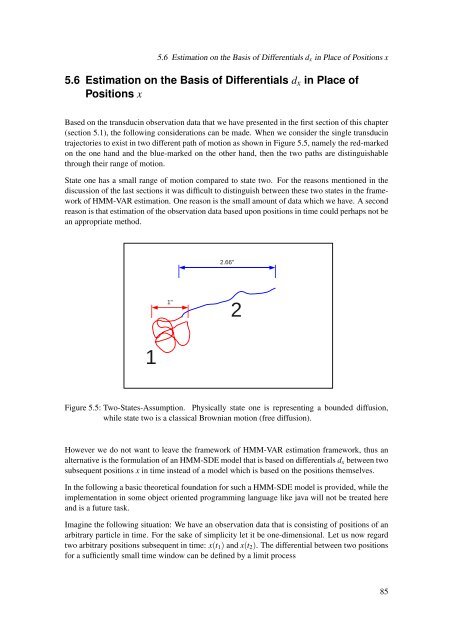Diffusion Processes with Hidden States from ... - FU Berlin, FB MI
Diffusion Processes with Hidden States from ... - FU Berlin, FB MI
Diffusion Processes with Hidden States from ... - FU Berlin, FB MI
Create successful ePaper yourself
Turn your PDF publications into a flip-book with our unique Google optimized e-Paper software.
5.6 Estimation on the Basis of Differentials d x in Place of Positions x5.6 Estimation on the Basis of Differentials d x in Place ofPositions xBased on the transducin observation data that we have presented in the first section of this chapter(section 5.1), the following considerations can be made. When we consider the single transducintrajectories to exist in two different path of motion as shown in Figure 5.5, namely the red-markedon the one hand and the blue-marked on the other hand, then the two paths are distinguishablethrough their range of motion.State one has a small range of motion compared to state two. For the reasons mentioned in thediscussion of the last sections it was difficult to distinguish between these two states in the frameworkof HMM-VAR estimation. One reason is the small amount of data which we have. A secondreason is that estimation of the observation data based upon positions in time could perhaps not bean appropriate method.2.66"1"21Figure 5.5: Two-<strong>States</strong>-Assumption. Physically state one is representing a bounded diffusion,while state two is a classical Brownian motion (free diffusion).However we do not want to leave the framework of HMM-VAR estimation framework, thus analternative is the formulation of an HMM-SDE model that is based on differentials d x between twosubsequent positions x in time instead of a model which is based on the positions themselves.In the following a basic theoretical foundation for such a HMM-SDE model is provided, while theimplementation in some object oriented programming language like java will not be treated hereand is a future task.Imagine the following situation: We have an observation data that is consisting of positions of anarbitrary particle in time. For the sake of simplicity let it be one-dimensional. Let us now regardtwo arbitrary positions subsequent in time: x(t 1 ) and x(t 2 ). The differential between two positionsfor a sufficiently small time window can be defined by a limit process85









